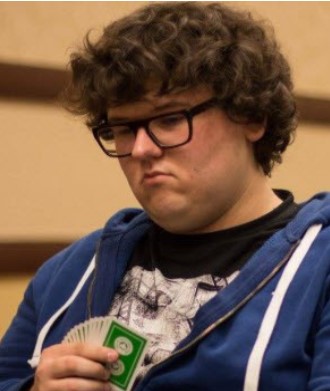Marc Smith visits the final of the 2022 French Division Nationale Open
The top division in the Open section of the 2022 French National League finished with the team captained by Romain Zaleski heading the 12-team field by a considerable margin. Behind them in second place, was the team captained by Pierre Zimmermann. The other qualifiers for the knockout stage were led by Jerome Rombaut and Lionel Sebbane.
In the semi-finals, ZALESKI defeated ROMBAUT 132-114 and ZIMMERMAN beat SEBBANE 125-110, setting up a final between the two pre-tournament favourites. For ZALESKI, Thomas Bessis was unavailable for the final, so they played five-handed, Frederic Volker and Irish star Tom Hanlon playing throughout, with Romain Zaleski, Philippe Cronier and Cedric Lorenzini rotating as a threesome. The ZIMMERMANN team fielded three partnerships, Pierre Zimmermann-Franck Multon, Monaco’s Jean Charles Alavena playing with Polish star Krzysztof Martens, and two members of Poland’s winning 2015 Bermuda Bowl team, Michal Klukowski-Piotr Gawrys.
The format was a 96-board final, divided into six 16-board stanzas. As usual, we begin with some problems for you to consider. Firstly, with just your side vulnerable, you are West holding:
What do you bid?
Next, with just the opponents vulnerable, you hold as East:
What do you bid?
Finally, with both sides vulnerable, you hold this collection in the West seat:
What, if anything, do you open?
While you mull those over, we join the thousands who tuned in to BBO VuGraph to watch the action. Many were still finding their seats as both sides bid to slam on Board 1, but from the opposite sides of the table. With a diamond side-suit of A-x opposite Q-10-x and the ace of trumps missing, you obviously want to play from whichever side puts the ♦K on lead. One pair did, of course, and perhaps the other could have been beaten had the opening leader’s eye alighted on a diamond from four low. An early chance missed, perhaps. Then came a huge slice of poor fortune for Martens-Allavena, who bid to 7NT needing six tricks from a diamonds suit of AKQJ9x opposite a singleton. The suit split 5-1 offside and, with Lorenzini-Zaleski stopping in 6NT at the other table, that was a massive 17 IMPs to ZALESKI. Then came the first of this week’s bidding problems:
It looks like West is worth a game try after a simple raise of his response. With the Poles adhering to the French style of virtually guaranteeing four-card support for East’s raise to 2♠, Michal Klukowski was focused only on how high to bid, so he made a help-wanted game try in diamonds. Piotr Gawrys accepted and Cedric Lorenzini led the ♣2. South’s ♣10 forced the king, so Klukowski drew trumps and played on diamonds. South won with the ♦A and exited with a diamond. After cashing his second diamond winner, Klukowski did the obvious thing and took the losing club finesse. Declarer still had two hearts to lose, so that was one down: E/W -100 but that was likely to be a flat board, wasn’t it?

With Irish star Tom Hanlon probably influenced by sacrilegious ideas peddled by the heathen Brits, Volcker knew that his partner would often hold only three trumps for his raise to 2♠. His focus was therefore more on which strain to play, rather than just level. In this light, his 2NT continuation is clearly an excellent description of this West hand, invitational and balanced. With an equally square collection, Hanlon then had a clear raise to the nine-trick game.
Kyzysztof Martens led the ♣7 here, South’s ten losing to declarer’s king. A diamond to the king lost to the ace and Jean-Charles switched to a low heart, ducked to North’s jack. When Martens continued with ace and another heart, declarer had nine tricks as long as spades split. When the ♣A also dropped South’s queen, Volcker could claim an overtrick: E/W +630 and 12 IMPs to ZALESKI, who led 52-14 after just ten boards. By the end of the first stanza, though, ZIMMERMAN had recovered 23 IMPs and trailed by just 15.
The action began again almost immediately, with a substantial swing on the second deal of the next stanza, where the team captain faced the second of this week’s problem hands.

Romain Zaleski was the playing captain of the team that finished second in the Open Teams at the 2013 European Transnational Championships in Ostend, earning in the process what may be the last medal collected from a major championship by the legendary Benito Garozzo. Zaleski was a member of the Italian team that reached the quarter-finals of the Open Teams at the 2012 World Bridge Games in Lille, and he has been the playing captain of the French team at the European Champions Cup three times, finishing fourth in 2014 and third in 2017.
On this deal, he made the key decision after Pierre Zimmermann’s vulnerable 2♥ opening had been doubled and raised. Zaleski jumped to game in the chucky four-card major on his 4-1-6-2 shape and Philippe Cronier raised to slam. Although Zaleski’s trump suit split 4-1, the diamonds behaved and thus there were 13 tricks in diamonds, spades or no-trumps. E/W +1010.
In the other room, the Polish Bermuda Bowl winners had the auction to themselves:
Michal Klukowski’s opening Polish 1♣ was either natural, a weak no-trump type, or any 17+, and the 1♠ response showed positive values with at least four spades. Opener’s 2♦ rebid then showed 18+ HCP and at least three spades. Piotr Gawrys could now have advanced with a natural 3♦, showing 4♠/5+♦ and 9-11, but he presumably downgraded his hand because of the poor quality of his diamonds and the questionable value of the singleton king. The sequence he chose showed either 4♠/5♦ with 7-8 HCP or 4♠/4+♦ with 9-10. When Gawrys cue-bid in hearts, he denied a diamond control and, when he then raised 4♠ to the five-level, he not only denied a high club but also a third round diamond control. Afraid of something like KQxx/KJx/Jxxx/xx opposite, Klukowski decided that the odds were against slam and passed. E/W +510 and 11 IMPs to ZALESKI.
Then came a deal on which the question was “How high dare you pre-empt?” This was the last of this week’s problem hands:
Gone are the days when four cards in the other major stopped people pre-empting in first seat, so the question on this West hand was very likely to be a case not of ‘if’ but of ‘how many?’. Philippe Cronier opted for a middle-of-the-road 3♥ opening, which seems reasonable at this vulnerability. Franck Multon came in with a takeout double and Pierre Zimmermann responded in his longest suit.
4♦ was not a particularly happy spot for declarer. Cronier led his club and declarer accurately played a trump to the ace at trick two. However, having removed West’s singleton diamond, declarer must then abandon trumps in order to get out for two down. When Zimmermann played a second round of trumps, the defenders were assured of six tricks. Vulnerable undertricks add up quickly, so that was E/W +300 but the silver lining was that declarer in 4♥ has just one trick to lose in each side suit, so E/W can potentially make +620.

Youthful optimism can be a wonderful thing, and Michal Klukowski got his side off to an excellent start when he decided that this West hand was worthy of a 4♥ opening. Frederick Volcker’s double deepened the quagmire in which N/S were floundering and, with 4♥-X booked to make for E/W +790, Tom Hanlon had no winning decision available. He did as well as he could, opting to remove the double to 4NT, showing both minors. Volcker obviously chose clubs, but Piotr Gawrys duly wielded the axe and led a trump.
Declarer drew trumps and then needed to play a heart to give himself a chance of making nine tricks by reading the end position and endplaying East to concede a diamond trick. When declarer played a diamond to his queen after taking the third round of trumps in dummy, he was booked for three down. E/W +800 and 11 IMPs to ZIMMERMANN.
Fortune favours the brave, it would seem, and if you needed further proof then take a look at the penultimate deal of the first half:
Cedric Lorenzini transferred to hearts and then not unreasonably settled for a partscore. Piotr Gawrys backed in with 2NT (showing minors) and, when it became apparent that the Poles had found a playable spot, Lorenzini pressed on to the three-level with his six-card suit.
Klukowski opened the ♠A and switched to a club at trick two. Philippe Cronier captured East’s ♣K with the ace, cashed the ♥K, and led the ♥10, covered by queen and ace. After cashing the ♥J, Cronier then led the ♠Q, establishing a discard for one of dummy’s diamond losers. Klukowski could score his second high spade, his trump winner and the ♦A only: N/S +140.
Pierre Zimmermann first appeared on the international bridge scene with a French team at the 1998 World Championships in Lille. His first major victory came in the Transnational Teams at the 2007 World Championships in Shanghai, playing with Franck Multon, Thomas and Michel Bessis of France, and Italians Fantoni/Nunes. He won the same event in 2009 in Sao Paulo and in 2015 in Chennai. He has also collected three European titles along the way, including the Open Teams at the 2012 European Teams Championships in Dublin, representing Monaco.

Franck Multon did not mess around on this deal, simply transferring to hearts at the four-level. Tom Hanlon kicked off the defence with a top spade and got a length signal from his partner. Looking at things from West’s viewpoint, you appear to have three top winners and a certain trump trick. What could go wrong?
As declarer is known to hold four spades, West knows that one of dummy’s diamonds can be discarded. What if declarer also holds ♣A-K-Q? Suppose you switch to a club at trick three: declarer would be able to play trumps, finessing against you queen. He would then cash two high clubs, throwing one diamond, and two spade winners, discarding dummy’s second diamond as you ruffed in with your trump winner. The answer seems clear, and Hanlon duly cashed his ♦A at trick three, before exiting with a third round of spades. It would seem that declarer now has four unavoidable losers, but Zimmermann had other ideas.
After winning with the ♠Q, declarer crossed to the ♥K and successfully ran the ♥10. He then cashed the ♦K and ruffed his third diamond in dummy. After taking the club finesse, he then advanced the winning ♠J. Of course, West discarded a club, but Zimmermann ruffed his winner, reducing dummy to the same number of trumps as West. A club to the ace at trick eleven then put declarer back in his hand, enabling him to pick up West’s ♥Q via a trump coup. Nicely played! N/S +620 and 10 IMPs to ZIMMERMANN, who had turned around the early deficit and led 117-92 at the midway point of the match.
We will return next week to see the highlights from the 48 boards remaining in this final.
